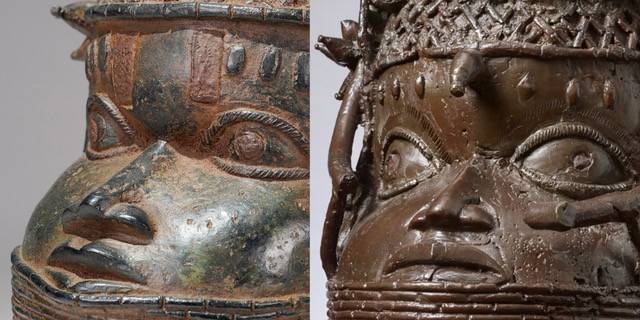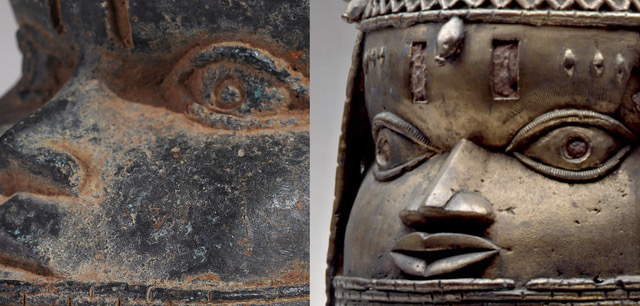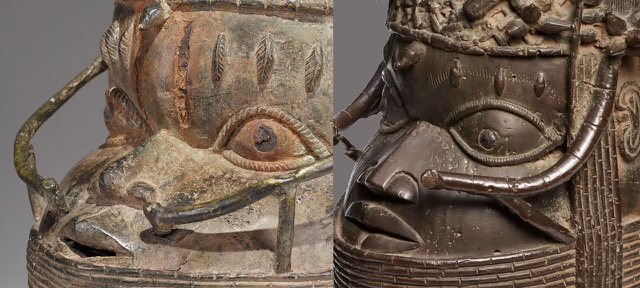Galerie Wolfgang Jaenicke
An Uhunmwu-Elao
An Uhunmwu-Elao
Couldn't load pickup availability
An Uhunmwu-Elao commemorative head of an Ọba, in the style of Benin, casted in bronze, iron inlays as pupils, regalia of coral beads, a cap-like crown and a high collar of coral necklaces, symbolizing the power and dignity of the Oba. Different layers of encrusted oxidations. The Uhunmwu-Elao commemorative head has not been cleaned and is nevertheless relatively well preserved. It shows only traces of a dust patina and breakouts, which are difficult to determine whether they are minor casting defects or whether they were caused by corrosion.
After the death of an Oba, an altar was built for him in a closed courtyard of the Benin palace. One of the most important objects on these altars were memorial heads of the deceased cast from brass.A carved ivory tusk once rose from the calotte of these commemorative heads. Extensive rituals and regular sacrifices at this altar by the successor confirmed his ties to the royal ancestors and increased his spiritual power. See Digital Benin, the Uhunmwu-Elao commemorative heads.
Lit.: Felix von Luschan, Die Altertümer von Benin, Band 1, Berlin 1919, S. 355-358. Philip J. C. Dark: An introduction to Benin art and technology, Oxford 1973, S. 95.William Fagg, Bildwerke aus Nigeria, München 1963, S. 44. Armand Duchateau Benin. Kunst einer Afrikanischen Königskultur, München 1995, S. 45-53.

1. Comparison of an Uhunmwu-Elao collected by Wolfgang Jaenicke (Left) and on DIGITAL BENIN (Right).
2.Comparison of an Uhunmwu-Elao collected by Wolfgang-Jaenicke (Left) and on DIGITAL BENIN (Right).

3. Comparison of an Uhunmwu-Elao collected by Wolfgang Jaenicke (Left) and on DIGITAL BENIN (Right).
As anthropologist Till Förster once noted in his study of Senufo bronzes, even the titles of books—Shining Like Gold—reflect this obsession with visual brilliance. The same holds true for Benin bronzes. Many were cleaned to the point of near-modern appearance, polished not for conservation, but for display.
Digital Benin and the Return of the Colonial Narrative
At the turn of the 20th century, the media spectacle around the looting of Benin City turned these bronzes into a global sensation. Now, 130 years later, the objects are once again at the center of public attention—this time under the banner of “colonial guilt.” And while the restitution debate is essential, it risks being entangled in a new ideological framework that may obscure more nuanced questions.
One such question is this:
Are all the objects we seek to restitute truly old, original, and authentic?
In both 1900 and today, the Benin bronze market includes not only looted and legally purchased originals, but also reproductions—some made with remarkable skill. The foundry guilds in Benin remained active well into the 20th century, and modern workshops continue to produce bronze heads and plaques for global markets, from Catawiki to eBay. As a result, distinguishing between historical artifacts and high-quality copies is not always straightforward—nor is it a concern that DIGITAL BENIN currently addresses.
The Need for Scientific Verification
Historical figures like Felix von Luschan, one of the early collectors of Benin art in Berlin, were already cautious in making attributions. He relied primarily on stylistic comparisons. Today, we have better tools. Thermoluminescence (TL) analysis, for instance, can help date the inner cores of bronzes, offering a much-needed empirical method to complement art-historical intuition.
If Digital Benin and other restitution-focused platforms are serious about doing justice to the objects they present, they must expand their methodological toolkit. Scientific analysis should be integrated into provenance studies—not as an afterthought, but as a core component. Otherwise, we risk building a new myth around the bronzes: one that is ethically motivated but historically imprecise.
Conclusion: Toward a Broader Provenance Debate
The case of the Uhunmwu-Elao heads on Digital Benin is not just about one category of bronze sculpture. It reflects a deeper problem in how museums—and now digital platforms—present objects with complex, layered histories. In light of this, three points are worth emphasizing:
1. Current provenance research on DIGITAL BENIN is shaped by a narrow ideological lens, often centered on colonial guilt rather than empirical analysis.
2. Many objects appear to have been significantly altered—cleaned, restored, or even recontextualized—in ways that erase their original material histories.
3. Future research must include scientific methods like TL testing to validate claims of authenticity and better understand the full life cycle of these artifacts.
Height: 32,5 cm
Weight: 6 kg


































